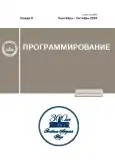Effective Lower Bounds on the Matrix Rank and Their Applications
- Autores: Zverkov O.A.1, Seliverstov A.V.1
-
Afiliações:
- Institute for Information Transmission Problems (Kharkevich Institute), Russian Academy of Sciences
- Edição: Nº 5 (2023)
- Páginas: 79-86
- Seção: COMPUTER ALGEBRA
- URL: https://journals.rcsi.science/0132-3474/article/view/141787
- DOI: https://doi.org/10.31857/S0132347423020176
- EDN: https://elibrary.ru/MHEYDZ
- ID: 141787
Citar
Texto integral
Resumo
We propose an efficiently verifiable lower bound on the rank of a sparse fully indecomposable square matrix that contains two non-zero entries in each row and each column. The rank of this matrix is equal to its order or differs from it by one. Bases of a special type are constructed in the spaces of quadratic forms in a fixed number of variables. The existence of these bases allows us to substantiate a heuristic algorithm for recognizing whether a given affine subspace passes through a vertex of a multidimensional unit cube. In the worst case, the algorithm may output a computation denial warning; however, for the general subspace of sufficiently small dimension, it correctly rejects the input. The algorithm is implemented in Python. The running time of its implementation is estimated in the process of testing.
Sobre autores
O. Zverkov
Institute for Information Transmission Problems (Kharkevich Institute), Russian Academy of Sciences
Autor responsável pela correspondência
Email: zverkov@iitp.ru
Russia, 127051, Moscow, Bol’shoi Karetnyi per. 19/1
A. Seliverstov
Institute for Information Transmission Problems (Kharkevich Institute), Russian Academy of Sciences
Autor responsável pela correspondência
Email: slvstv@iitp.ru
Russia, 127051, Moscow, Bol’shoi Karetnyi per. 19/1
Bibliografia
- Геворкян М.Н., Королькова А.В., Кулябов Д.С., Севастьянов Л.А. Пример модульного расширения системы компьютерной алгебры // Программирование. 2020. № 2. С. 30–37. DOI: Перевод: Programming and Computer Software. 2020. V. 46. № 2. P. 98–104.https://doi.org/10.31857/S0132347420020065
- Chistov A.L. Fast parallel calculation of the rank of matrices over a field of arbitrary characteristic // In: L. Budach (eds) Fundamentals of Computation Theory. FCT 1985. Lecture Notes in Computer Science, vol. 199. Springer, Berlin, Heidelberg, 1985. P. 63–69. https://doi.org/10.1007/BFb0028792
- Mulmuley K. A fast parallel algorithm to compute the rank of a matrix over an arbitrary field // Combinatorica. 1987. V. 7. № 1. P. 101–104. https://doi.org/10.1007/BF02579205
- Malaschonok G., Tchaikovsky I. About big matrix inversion // In: Abramov S.A., Sevastyanov L.A. (eds) Computer algebra. Moscow: MAKS Press, 2021. P. 81–84. https://doi.org/10.29003/m2019.978-5-317-06623-9
- Малашонок Г.И., Сидько А.А. Суперкомпьютерная среда выполнения для рекурсивных матричных алгоритмов // Программирование. 2022. № 2. С. 33–46. DOI: Перевод: Programming and Computer Software. 2022. V. 48. P. 90–101.https://doi.org/10.31857/S0132347422020091
- Cheung H.Y., Kwok T.C., Lau L.C. Fast matrix rank algorithms and applications // Journal of the ACM. 2013. V. 60. № 5. Article № 31. P. 1–25. https://doi.org/10.1145/2528404
- Abdeljaoued J., Malaschonok G.I. Efficient algorithms for computing the characteristic polynomial in a domain // Journal of Pure and Applied Algebra. 2001. V. 156. P. 127–145. https://doi.org/10.1016/S0022-4049(99)00158-9
- Переславцева О.Н. О вычислении характеристического полинома матрицы // Дискретная математика. 2011. Т. 23. № 1. С. 28–45. DOI: Перевод: Discrete Mathematics and Applications. 2011. V. 21. № 1. P. 109–128.https://doi.org/10.4213/dm1128
- Neiger V., Pernet C. Deterministic computation of the characteristic polynomial in the time of matrix multiplication // Journal of Complexity. 2021. V. 67. № 101572. P. 1–35. https://doi.org/10.1016/j.jco.2021.101572
- Chen Z. On nonsingularity of circulant matrices // Linear Algebra and its Applications. 2021. V. 612. P. 162–176. https://doi.org/10.1016/j.laa.2020.12.010
- Алаев П.Е., Селиванов В.Л. Поля алгебраических чисел, вычислимые за полиномиальное время. I // Алгебра и логика. 2019. Т. 58. № 6. С. 673–705. DOI: Перевод: Algebra Logiс. 2020. V. 58. P. 447–469.https://doi.org/10.33048/alglog.2019.58.601
- Алаев П.Е., Селиванов В.Л. Поля алгебраических чисел, вычислимые за полиномиальное время. II // Алгебра и логика. 2021. Т. 60. № 6. С. 533–548. DOI: Перевод: Algebra Logiс. 2022. V. 60. P. 349–359.https://doi.org/10.33048/alglog.2021.60.601
- Harris J., Tu L.W. On symmetric and skew-symmetric determinantal varieties // Topology. 1984. V. 23. № 1. P. 71–84. https://doi.org/10.1016/0040-9383(84)90026-0
- Harris J. Algebraic geometry. Springer-Verlag New York, 1992. 330 p. https://doi.org/10.1007/978-1-4757-2189-8
- Rubei E. Affine subspaces of matrices with constant rank // Linear Algebra and its Applications. 2022. V. 644. № 1. P. 259–269. https://doi.org/10.1016/j.laa.2022.03.002
- Селиверстов А.В. Двоичные решения для больших систем линейных уравнений // Прикладная дискретная математика. 2021. № 52. С. 5–15. https://doi.org/10.17223/20710410/52/1
- Кузюрин Н.Н. Полиномиальный в среднем алгоритм в целочисленном линейном программировании // Сибирский журнал исследования операций. 1994. Т. 1. № 3. С. 38–48.
- Kuzyurin N.N. An integer linear programming algorithm polynomial in the average case // In: Korshunov A.D. (eds.) Discrete Analysis and Operations Research. Mathematics and Its Applications. V. 355. P. 143–152. Springer, Dordrecht, 1996. https://doi.org/10.1007/978-94-009-1606-7
- Pan Y., Zhang F. Solving low-density multiple subset sum problems with SVP oracle // Journal of Systems Science and Complexity. 2016. V. 29. P. 228–242. https://doi.org/10.1007/s11424-015-3324-9
- Рыбалов А.Н. О генерической сложности проблемы о сумме подмножеств для полугрупп целочисленных матриц // Прикладная дискретная математика. 2020. № 50. С. 118–126. https://doi.org/10.17223/20710410/50/9
- Рыбалов А.Н. О генерической сложности проблемы вхождения для полугрупп целочисленных матриц // Прикладная дискретная математика. 2022. № 55. С. 95–101. https://doi.org/10.17223/20710410/55/7
- Селиверстов А.В. Эвристические алгоритмы распознавания некоторых кубических гиперповерхностей // Программирование. 2021. № 1. С. 65–72. DOI: Перевод: Programming and Computer Software. 2021. V. 47. № 1. P. 50–55.https://doi.org/10.31857/S0132347421010106
- Minc H. -matrices with minimal permanents // Israel Journal of Mathematics. 1973. V. 15. P. 27–30. https://doi.org/10.1007/BF0277177010.1007/BF02771770
- Seliverstov A.V., Lyubetsky V.A. About forms equal to zero at each vertex of a cube // Journal of Communications Technology and Electronics. 2012. V. 57. № 8. P. 892–895. https://doi.org/10.1134/S1064226912080049
- Schwartz J.T. Fast probabilistic algorithms for verification of polynomial identities // Journal of the ACM. 1980. V. 27. № 4. P. 701–717. https://doi.org/10.1145/322217.322225
- Harris C.R., Millman K.J., van der Walt S.J. et al. Array programming with NumPy // Nature. 2020. V. 585. № 7825. P. 357–362. https://doi.org/10.1038/s41586-020-2649-2
- Chen Y.A., Gao X.S. Quantum algorithm for Boolean equation solving and quantum algebraic attack on cryptosystems // Journal of Systems Science and Complexity. 2022. V. 35. P. 373–412. https://doi.org/10.1007/s11424-020-0028-6
Arquivos suplementares









